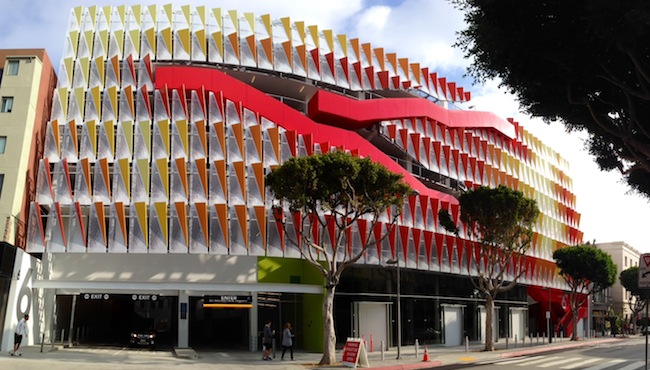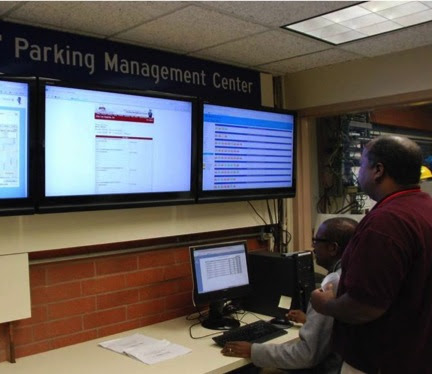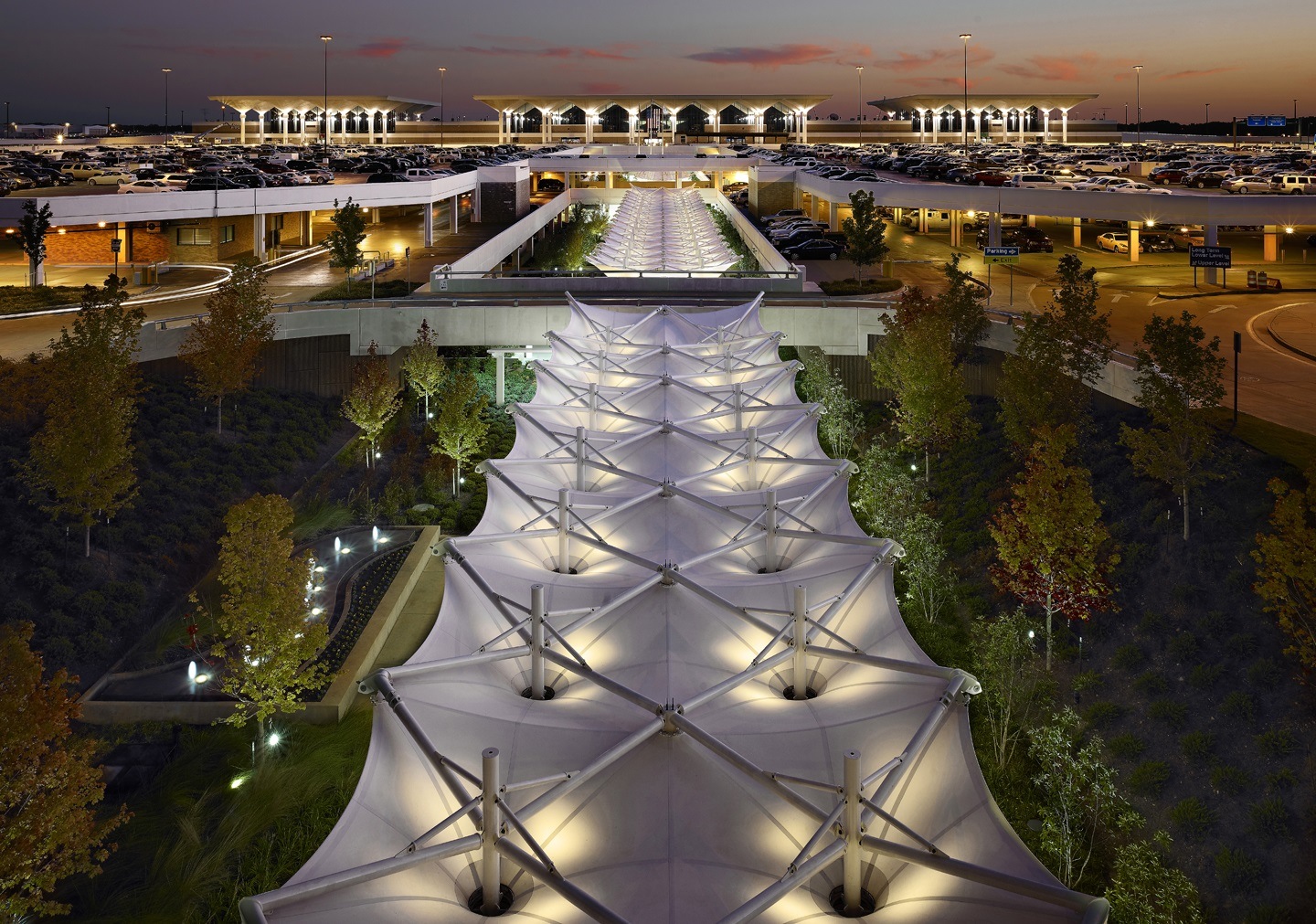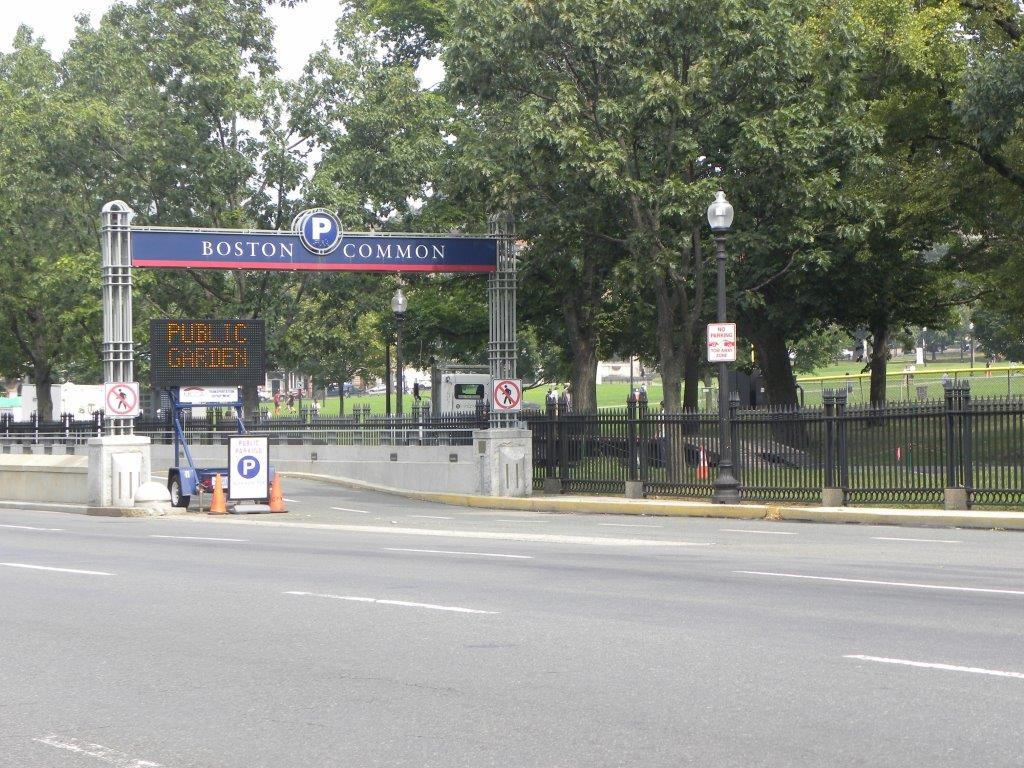Don't be shocked to learn that the architectural showpiece or inviting urban garden at the end of the street is actually a parking facility.
As the seven winners of the International Parking Institute (IPI) 2014 Awards of Excellence competition demonstrate, today's parking garages and lots are likely to be as easy on the eye as they are user- and earth-friendly.
Honorees in the 32nd annual competition range from the visually striking Park Place in Missoula, Montana, and the Ajax GO Parking Garage in Toronto, Canada, to the green and modern Boston Common Parking Garage, situated underneath America's oldest park.
"Although they differ in appearance and use, all share a commitment to improving the cities they serve," says IPI Executive Director Shawn Conrad, CAE.
"The 2014 winners showcase how significantly parking facilities and operations have been transformed in recent years as a result of advances in technology focused on efficiency and sustainability," Conrad says.
"Many are architecturally striking hubs that facilitate mass and alternative transit and a variety of pedestrian activities; others conceal their practical function with lushly planted parks that enhance the entire neighborhood. It's fair to say parking is transforming communities, making them greener, easier to navigate, and certainly more livable."
Winners were selected by a panel of judges that included architects, parking corporations, and city, airport, and university officials.
The projects receiving top honors are:
Award for Architectural Achievement
Park Place; Missoula, Mont.
Building Team:
Owner: Missoula Parking Commission
Architect: MacArthur, Means & Wells
Partner/Project Manager: Missoula Redevelopment Agency
Contractor: Gordon Construction
Parking Consultant/Structural Engineer: Carl Walker
Consulting Engineers: Beaudette
Civil Engineer: WGM Group
Landscape Architect: Landscape Architecture Studio
Mechanical/Electrical Engineer: DC Engineering
Located in the central business district of Missoula, Mont., Park Place is a five-level, 333-space public parking structure with 3,000 square feet of street-level retail space.
The project had five architectural goals: it should be fresh, urban, and progressive; it should support the city's urban design and economic vitality; it should maximize the number of parking spaces per dollar and consider both construction and life-cycle costs; it should be driver-friendly (easy to navigate, light and bright, and safe and accessible); and it should demonstrate municipal stewardship for the environment.
The small site dictated a single-helix design with two-way flow. A post-tensioned structure increases the sense of height and airiness inside and improves slab durability. Cast-in-place concrete maximized the use of local materials and labor, and the project is net-zero, with a photovoltaic array that powers the entire building. State-of-the-art lighting and control systems and a green elevator reduce electrical load by 64 percent from energy code standards.
Best Design of a Parking Facility with Fewer than 800 Spaces
City of Santa Monica Parking Structure 6; Santa Monica, Calif.
Building Team:
Owner: City of Santa Monica
Architect of record: International Parking Design
Structural engineer: Culp & Tanner
Façade design: Studio Jantzen
Civil engineer: Incledon Consulting Group
Mechanical/electrical engineer: Levine/Seegel
General contractor: Morley Builders
Parking Structure 6 exemplifies Santa Monica, California's strategic plan to retrofit, rebuild, and plan for future parking needs with a focus on sustainability.
Completed in December 2013, the structure occupies a prime downtown location adjacent to the popular Third Street Promenade, and its impressive facade already has become a local landmark. Designed to be energy-saving with low operating costs, the city's most sustainable parking structure features a powerful solar panel system and energy efficient lighting with sensors; its interior filters and maximizes natural light.
It is pedestrian- and bicycle-friendly, accessible to those with disabilities, and offers electric vehicle (EV) chargers on all levels. Its cutting edge equipment and other amenities minimize egress congestion and functionality.
Best Design of a Parking Facility with More than 800 Spaces
Ajax GO Station; Toronto, Canada
Building Team:
Owner: GO Transit, a Division of Metrolinx
Architect, Architect-of-Record, Landscape, Civil Engineer, Planning & Traffic Engineer: IBI Group
Structural Engineer, Engineer-of-Record & Parking Consultant: Read Jones Christoffersen, Ltd.
Design Builder: Kenaidan Contracting, Ltd.
Mechanical and Electrical Engineer: MCW Consultants Limited
Toronto, Canada's stunning Ajax GO Parking Garage appears to be a green box floating lightly above the ground anchored by glass towers with an origami-inspired canopy, making it one of the city's architectural treasures.
With pre-cast concrete columns serving as its visual "bones," the structure's lower levels are distinguished by an asymmetric system of perforated screens, and its three upper floors feature green aluminum tubes installed vertically in a scalloped-wave pattern. Inside, the six-level parking structure provides 1,500 parking spaces for GO passenger rail patrons and connects with an existing bus loop.
Exit stairs and elevator cores serve as wayfinding beacons and help filter natural light. Its designers paid particular attention to the geometric configuration of the bus loop and surface entrances, enabling efficient circulation for the structure and Kiss & Ride drop-off areas.
Best Design/Implementation of a Surface Parking Lot
201 Claremont Street Green P +; Toronto, Canada
Building Team:
Owner & Project Manager: Toronto Parking Authority
Architect: Marton Smith Landscape Architects
Planner: EGF Associates
Storm Water Management: Cook Consulting Engineers Limited
General Contractor: Mopal Construction Limited
Since its May 2013 opening, the Toronto Parking Authority (TPA)'s 201 Claremont Street P + has been praised by the neighboring community for meeting and exceeding the city's development and greening standards for surface parking facilities. The 43-space lot has created a new green precedent for TPA and inspired other authority projects now in the works.
Designed in consultation with the local community, it accommodates existing and future short-term public parking while aesthetically improving its 201 Claremont Street neighborhood. A paved area provides pedestrian connections and masonry seating areas, and a complementary lot incorporates permeable pavers in drive aisles to create a sustainable stormwater management system.
High-albedo surface materials and tree plantings reduce the urban heat island effect. A unique living wall of live willows and raised concrete planting beds screens parking, reduces salt damage, and protects neighbors from pedestrian traffic. Primarily native plantings were specifically chosen for seasonal interest and year-round screening.
Innovation in a Parking Operation or Program
LADOT Express Park; Los Angeles, California
Building Team:
Owner: City of Los Angeles, California, Dept. of Transportation
Project Manager: LADOT Parking Meters Division
Prime Contractor: Xerox State & Local Solutions
Pricing Engine Developer: Xerox Innovation Group
Does intelligent parking management reduce time spent cruising for parking and related traffic congestion and associated pollution? The Los Angeles Department of Transportation (LADOT) recently put this concept to the test.
From June 2012 through February 2014, its downtown LA Express Park™ operated as a U.S.-sponsored demonstration site for a complete intelligent transportation system (ITS), using vehicle sensors and a real-time parking guidance system to optimize the use of public on- and off-street parking.
Sensor data showed that the demand for parking remained high through the evening in many areas, so the city extended enforcement hours to 8 p.m. It eliminated rate zones and adjusted fixed rates based on each blockface's demand patterns.
When occupancy data suggested that a day-long fixed rate did not match variance in demand, the city substituted three Monday-to-Friday pricing periods and an all-day Saturday rate. By pricing each block based on occupancy thresholds, LADOT was able to increase parking availability and reduce circling for spaces.
Best Parking Facility Rehabilitation or Restoration
Memphis International Airport Ground Transportation Center; Memphis, Tennessee
Building Team:
Owner: Memphis Shelby County Airport Authority
Project Management, Parking Consultant, and Structural Engineer: Walker Parking Consultants, Inc.
Concept Architect: OGCB Incorporated Electrical Engineer of Record: LRK, Inc.
Architect-of-Record: Self + Tucker Architects
Program Manager: Parsons Transportation Group Inc.
General Contractor: Walker Restoration Consultants, Inc., Restoration Engineering, Flintco, Inc.
Graphics and Wayfinding: Clark Dixon Associates
Mechanical and Plumbing: GALA Engineering
Roadways/Civil Engineering: Pickering Firm, Inc.
Landscape Architect: Ritchie Smith Associates
Pedestrians are the beneficiaries of the Memphis International Airport's convenient pedestrian plaza between the terminal and the new Consolidated Ground Transportation Center.
Portions of an existing short/long-term parking structure were removed to create an attractive, canopy-covered atrium with moving walkways, water features, landscaped areas, and outdoor speakers that broadcast music from local artists. Its electrical and mechanical systems are controlled from the airport's central control system.
The airport's parking facilities also underwent major repairs, including concrete resurfacing, traffic topping replacement, installation of latex-modified overlays, re-striping, expansion joint replacement, and floor strengthening. Architectural improvements included lighting of pedestrian tunnels, structural upgrades to support vehicle loads on a pedestrian bridge, a new infill valet ramp, and license plate recognition (LPR) systems. To avoid holiday traffic, repairs were selectively phased, and employee and overflow parking were temporarily relocated.
Signage and dedicated construction-access roads helped avoid backups, and temporary masking boards separated the usable areas of the garage from the construction zone.
Award for New Sustainable Parking and Transportation Facilities Excellence
Boston Common Garage; Boston, Massachusetts
Building Team:
Owner: Massachusetts Convention Center Authority
Executive Director: James E. Rooney
Director of Facilities Operations: Fred Peterson
Account Manager: Dave Levesque, Amano McGann
Facility Manager: Sammy Yemane, SP+ Corporation
The Boston Common Garage, a 1,300-space facility located underneath America's oldest public park, is as green below as it is above. From new EV charging stations to a partnership with the Zipcar car-sharing service, the garage is one of the most environmentally-friendly in the city.
Zipcar and hybrid vehicles were given priority parking near the garage's four kiosks that lead to the Common, and a centralized parking area for EVs and hybrids was branded to create a visible and convenient presence for the green effort.
Entry and exit gates were automated to cut down on idling vehicles, and the garage's lighting was replaced with energy-efficient options that cut wattage use in half. Automatic vehicle identification (AVI) readers allow EZ Pass holders monthly parking access, helping reduce vehicle idling and carbon emissions. The garage's charging stations were funded through a U.S. Department of Energy grant.
Related Stories
Sponsored | Building Enclosure Systems | May 16, 2023
4 steps to a better building enclosure
Dividing the outside environment from the interior, the building enclosure is one of the most important parts of the structure. The enclosure not only defines the building’s aesthetic, but also protects occupants from the elements and facilitates a comfortable, controlled climate. With dozens of components comprising the exterior assemblies, from foundation to cladding to roof, figuring out which concerns to address first can be daunting.
Multifamily Housing | May 16, 2023
Legislators aim to make office-to-housing conversions easier
Lawmakers around the country are looking for ways to spur conversions of office space to residential use.cSuch projects come with challenges such as inadequate plumbing, not enough exterior-facing windows, and footprints that don’t easily lend themselves to residential use. These conditions raise the cost for developers.
Headquarters | May 16, 2023
Workplace HQ for party clothing company Shinesty celebrates its bold, whimsical products
The new Denver headquarters for Shinesty, a party clothing company, was designed to match the brand’s fun image with an iconic array of colors, textures, and prints curated by the design agency, Maximalist. Shinesty’s mission, to challenge the world to live more freely and “take itself less seriously,” is embodied throughout the office interior.
Office Buildings | May 15, 2023
Sixteen-story office tower will use 40% less energy than an average NYC office building
This month marks the completion of a new 16-story office tower that is being promoted as New York City’s most sustainable office structure. That boast is backed by an innovative HVAC system that features geothermal wells, dedicated outdoor air system (DOAS) units, radiant heating and cooling, and a sophisticated control system to ensure that the elements work optimally together.
Life of an Architect Podcast | May 15, 2023
Life of an Architect Podcast Ep. 125: What Makes a Great Employee?
How do you define a great employee? The answer is most likely dependent on who is attempting to respond: the employee or the employer. Life of an Architect's Bob Borson, FAIA, and Andrew Hawkins, AIA, talk about the traits and characteristics of great employees.
K-12 Schools | May 12, 2023
In Virginia, a new high school building helps reimagine the experience for 1,600 students
In Virginia, the City of Alexandria recently celebrated the topping out of a new building for Alexandria City High School. When complete in 2025, the high-performance structure will accommodate 1,600 students.
University Buildings | May 11, 2023
New ‘bold and twisting’ building consolidates School of Continuing Studies at York University
The design of a new building that consolidates York University’s School of Continuing Studies into one location is a new architectural landmark at the Toronto school’s Keele Campus. “The design is emblematic of the school’s identity and culture, which is centered around accelerated professional growth in the face of a continuously evolving labor market,” according to a news release from Perkins&Will.
Sustainability | May 11, 2023
Let's build toward a circular economy
Eric Corey Freed, Director of Sustainability, CannonDesign, discusses the values of well-designed, regenerative buildings.
Hotel Facilities | May 9, 2023
A new camping destination near Utah’s Zion National Park offers a variety of all-season lodgings and amenities
Outdoor lodging brand AutoCamp has opened a new camping destination near Utah’s Zion National Park. A 16-acre property, AutoCamp Zion is located between the Virgin River and the desert of Southern Utah.
Headquarters | May 9, 2023
New Wells Fargo development in Texas will be bank’s first net-positive campus
A new Wells Fargo development in the Dallas metroplex will be the national bank’s first net-positive campus, expected to generate more energy than it uses. The 850,000-sf project on 22 acres will generate power from solar panels and provide electric vehicle charging stations.

























